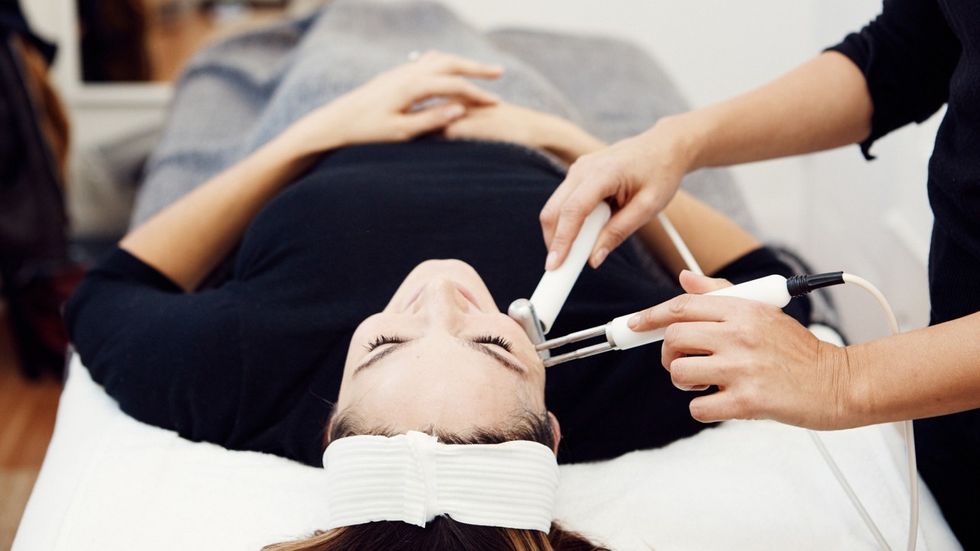
30 January, 2019
10 November, 2021
Dealing with acne sucks; there’s no possible way to sugarcoat it. But the fact is that we all suffer from pimples, blackheads, and cysts occasionally, no matter how fresh-faced your Instagram feed appears to look. I know from experience how debilitating it is to feel like you have no control over your skin—after I switched from the pill to an IUD four years ago, my hormonal acne went insane. After much trial and error, plus a prescription-strength tretinoin cream and daily spironolactone pill, I finally found a routine that works for my skin and limits my cystic acne to the intermittent flare-up. What I was not prepared for, however, were the dark clusters of brownish-red scars along my chin and jawline.
Scarring from acne is unfortunately quite common, which can make finally eliminating your breakouts feel somewhat bittersweet. Plus, not all acne scars require the same treatment, since the damage to your skin appears differently depending on the severity of your acne (deep, cystic acne is the most common culprit) and the color of your complexion. To break down the best way of treating residual scarring, I turned to two leading dermatologists, Dr. Anne Chapas of Union Square Laser Dermatology, and Dr. Carlos Charles, founder of Derma di Colore. Check out their advice about identifying the different types of acne scars, what your treatment options are at home, and when it’s time to visit a professional.
Scarring from acne is unfortunately quite common, which can make finally eliminating your breakouts feel somewhat bittersweet. Plus, not all acne scars require the same treatment, since the damage to your skin appears differently depending on the severity of your acne (deep, cystic acne is the most common culprit) and the color of your complexion. To break down the best way of treating residual scarring, I turned to two leading dermatologists, Dr. Anne Chapas of Union Square Laser Dermatology, and Dr. Carlos Charles, founder of Derma di Colore. Check out their advice about identifying the different types of acne scars, what your treatment options are at home, and when it’s time to visit a professional.
What are the different types of acne scars?
The same way that not all acne is alike, the leftover damage can be just as varied. As Dr. Chapas explained, “Acne scars generally happen because of the inflammation in the acne lesion. It’s rare to occur in small, pore-clogging-type acne.” Most scars are either a discoloration, known as hyperpigmentation; an atrophic scar, which is raised from the skin over-producing collagen; an ice-pick scar, a small, narrow indentation; a boxcar scar, which have angular, well-defined edges; or a rolling scar, which have a wide, wave-like appearance and are shallow in depth.
Dr. Charles elaborated, “Oftentimes, particularly in darker skin tones, once acne resolves, dark marks left behind can take several weeks to months to resolve. Severe acne with significant inflammation can also lead to deeper true scars, such as ‘ice pick’ or ‘rolling’ scars.” Luckily, not all acne leaves a scar, but if you’re unsure, it’s always a good idea to consult a dermatologist.
What are the best treatment options for hyperpigmentation scars?
There are several different options to treat discoloration from acne. Both dermatologists recommended starting with a topical retinoid, which helps exfoliate the skin and eliminate brown spots. But unless the scarring is very minor, it’s wise to supplement with another form of treatment. “In-office chemical peels can be used in conjunction with topical retinoids to aid in exfoliating areas of hyperpigmentation,” said Dr. Charles. “For darker skin tones, agents such as salicylic and glycolic acid can be used. Salicylic acid peels also assist in treating active acne while effectively helping to minimize hyperpigmentation.”
Dr. Chapas also recommended lasers to help fade red and brown spots. “Lasers, like Pulse Dye, KTP, or Clear & Brilliant, will heat up the excess blood vessels and redness, and your body will absorb the damaged tissue.” She stressed that all active acne needs to be resolved before treating scars with lasers. “Don’t even come in for evaluation unless you’re at less than five spots over three months.”

What are the best treatment options for atrophic or depressed scars?
The structure of a depressed scar is different than the rest of the skin on your face. Dr. Chapas explained, “It’s very compact collagen. It tethers the underlying skin underneath. We’re trying to replace the compacted collagen with normal, healthy collagen with lasers or subcision or filler.” Subcision, as Dr. Charles elaborated, is a surgical intervention to release the tethers on a bound-down, deeper scar.
Other options include resurfacing lasers, which Dr. Chapas considers to be the gold standard, ablative fractional laser, fractional pico laser, and needling devices, such as the in-office DermaPen (which will make your at-home microneedling sessions seem like seriously weak sauce).
How does acne-scar treatment vary for darker skin tones?
Darker skin is more susceptible to heat than lighter skin, and therefore needs extra attention during acne-scarring treatment. As Dr. Charles said, “As with all procedures performed on darker skin, one needs to be careful not to create or worsen hyperpigmentation. Peels must be selected with care to avoid deep peeling, which can sometimes lead to burns and worsening of scarring. Additionally, laser procedures must be used judiciously, with particular attention to minimizing heat and controlling the depth on the skin to prevent further hyperpigmentation.”
Are there any options for at-home treatment?
Over-the-counter products like vitamin C and hydroquinone are effective at fading hyperpigmentation, but are best suited for minor scarring and hyperpigmentation. Wearing SPF every day will not only help prevent new discoloration, but keep your current scars from worsening over time (and generally keep your skin healthy and protected from harmful UVA/UVB rays!).
Despite all of these options, Dr. Chapas did remind us that there is no magic cure for acne scarring. “Even with multiple treatments and modalities, we get to 50 to 70 percent [elimination of scars]. These [treatments] work better on younger patients with fresh scars as opposed to older, decades-old scars.” So if you’re dealing with acne scars, run, don’t walk to your dermatologist and start plotting out the best course of treatment as soon as possible. Just remember to have patience, as it might be a few months before you see the results you’re looking for appear. But in the end, your skin will thank you.
Photo: Shot on site at 6 Columbus, a Sixty Hotel; On Jonelle: Necklace, Baker & Black; Rings, Catbird; Hair, Angela Soto; Makeup, Andriani.
Want more stories like this?
Our Producer’s Super Simple Anti-Acne Skin-Care Routine
5 Beauty Treatments You Can Do While You Shower
How I Dealt with My Adult Acne Problem




